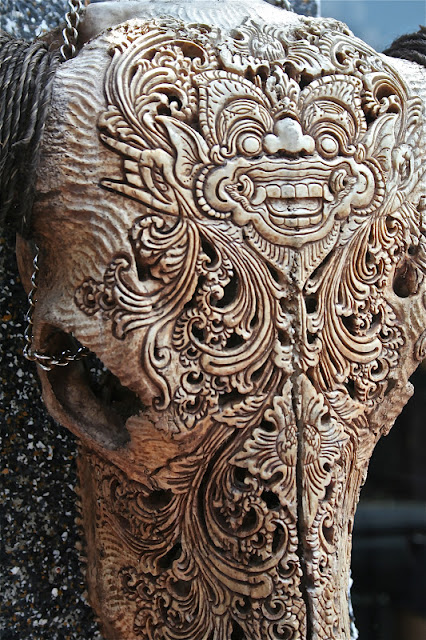 |
| One of the rooms at our hotel, the Tjampuhan. The restaurant is at left. A gorgeous setting. |
 |
| The view from our balcony |
 |
| Nature is the template for the design of Tjampuhan |
 |
| One of the spring-fed swimming pools |
Despite the economic drawbacks of being a tourist, Bali is a charming place. The jungle is always nearby, rushing streams run through the middle of Ubud at the base of cliffs with lush vegetation clinging to the rocks; brilliant butterflies, swooping swallows and bats flit through the garden-like village.
 |
| A hotel worker ceremoniously places incense, holy water and flowers on a shrine. |
 |
| Every day a fresh offering is placed on a special box beside each door of the hotel rooms. This was ours. |
 |
| Placing offerings on a shrine at a shop in town. |
 |
| This woman spent an hour placing flowers and incense around one of Ubud's temples. |
 |
| Baskets are found everywhere, hundreds on the sidewalks of Ubud. |
 |
| It is common to see people taking huge baskets of fruit to the temples at all hours. |
 |
| Offerings at a shrine in Ubud |
 |
| 15th century cave temple, Goa Gajah (Elephant Cave). |
 |
| Entrance to Goa Gajah |
 |
| The meditation room of the royal family from the Majahapit Empire. |
Outside of town, villages, with temples at their centers, remain the cultural fiber of Bali. Each Balinese village has three temples, one for each of the main Hindu gods: Brahma (the creator), Vishnu (the preserver), and Shiva (the destroyer). To see Balinese life, one must venture beyond the tourist centers. We spent a full day touring the countryside, visiting ancient temples, dining at the base of an active volcano, and observing everyday life of villagers and farmers.
 |
| Entrance to a village temple. |
 |
| Holy springs at temple in Sebatu Village. |
 |
| Altar detail |
 |
| Everyone must wear a sarong at temples. There are always sarongs to borrow as you enter. |
 |
| Part of Bali's vast irrigation system. |
 |
| Bali's famous rice paddy terraces |
 |
| Roadside fruit stand |
 |
| Winnowing rice at harvest time |
 |
| Mt Batur. The damage from the 1963 eruption can still be seen on its slopes and in the tongue of the lava flow in middle of the photo. |
 |
| A selection of Balinese coffees. The white cup in the middle contains luwak coffee, the beans of which have traveled through the digestive tract of a civet cat. |
Returning to Ubud, we took time to stroll the streets, take in some cultural events, and relax in the beauty of the lush surroundings.
 |
| An artist captures the beauty and grace of the Balinese |
 |
| There's that phallic obsession again. This time, it is a wooden call bell on our balcony. Each room has one. |
 |
| Balinese women carry a variety of things on their heads. Men never do: they use their shoulders to bear the weight. |
 |
| Some of the loads are quite imposing. |
 |
| Recess time at a local school |
 |
| Even the macaques at Monkey Forest let it all hang out! |
 |
| A gamalan band performs at the palace in Ubud. |
 |
| Traditional Balinese dancers. |
 |
| From a version of the Ramayana legend, performed at the palace. |
 |
| School entrance |
 |
| Palace wall carvings |
 |
| Traditional Balinese figures |
 |
| Lush sanctuaries are tucked away inside courtyards. |
 |
| Mythical demon carvings beautifully rendered on a cow skull |
